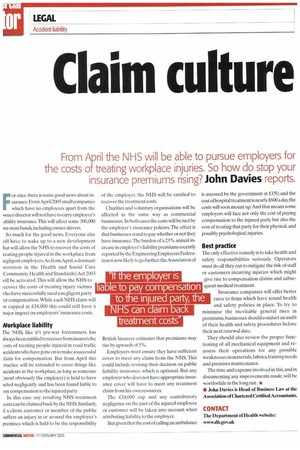Claim c 1 ture
Page 38

If you've noticed an error in this article please click here to report it so we can fix it.
From April the NHS will be able to pursue employers for the costs of treating workplace injuries. So how do stop your insurance premiums rising? John Davies reports.
For once there is some good news about insuranc.e.FromApril 2005 small companies which have no employees apart from the iwner/director will not have to carry employer's Lability insurance. This will affect some 300,000 ine-man bands, including owner-drivers.
So much for the good news. Everyone else vill have to wake up to a new development hat will allow the NHS to recover the costs of reating people injured in the workplace from iegligent employers.As from April. a dormant )rovision in the Health and Social Care Community Health and Standards) Act 2003 vill be activated. This will allow the NHS to .ecover the costs of treating injury victims vho have successfully sued a negligent party or compensation. While each NHS claim will ie capped at £34,000 this could still have a najor impact on employers' insurance costs.
Workplace liability
[he NI IS. like it's pre-war forerunners, has Always been entitled to recover from insurers the Liosts of treating people injured in road traffic Accidents who have gone on to make a successful laini for compensation. But from April this iractice will be extended to cover things like Accidents in the workplace, as long as someone most obviously the employer) is held to have acted negligently and has been found liable to a.y compensation to the injured party.
In this case any resulting NHS treatment costs can be claimed back by the NHS. Similarly. if a client, customer or member of the public suffers an injury in or around the employer's premises which is held to be the responsibility of the employer, the NHS will be entitled to recover the treatment costs.
Charities and voluntary organisations will be affected in the same way as commercial businesses. In both cases the costs will be met by the employer's insurance policies. The effect is that businesses stand to pay whether or not they have insurance.The burden of a 23% annual increase in employer's liability premiums recently reported by the Engineering Employers Federation is now likely to go further: the Association of British Insurers estimates that premiums may rise by upwards of 5°/0.
Employers must ensure they have sufficient cover to meet any claim from the NHS. This could include revising their decision on public liability insurance, which is optional. But any employer who does not have appropriate insurance cover will have to meet any treatment claim from his own resources.
The £34,000 cap and any contributory negligence on the part of the injured employee or customer will be taken into account when attributing liability to the employer.
But given that the cost of calling an ambulance is assessed by the government at £150, and the cost of hospital treatment is nearly £600 a day,the costs will soon mount up. And that means some employers will face not only the cost of paying compensation to the injured party but also the cost of treating that party for their physical, and possibly psychological,injuries.
Best practice
The only effective remedy is to take health and safety responsibilities seriously. Operators must do all they can to mitigate the risk of staff or customers incurring injuries which might give rise to compensation claims and subsequent medical treatment.
Insurance companies will offer better rates to firms which have sound health and safety policies in place. To try to minimise the inevitable general rises in premiums, businesses should conduct an audit of their health and safety procedures before their next renewal date.
They should also review the proper functioning of all mechanical equipment and reassess their operations for any possible weaknesses in materials, fabrics, training needs and premises maintenance.
The time and expense involved in this, and in documenting any improvements made, will be worthwhile in the long run. • • John Davies is Head of Business Law at the Association of Chartered Certified Accountants.
CONTACT
The Department of Health website: www.dh.gov.uk






























































































































































































